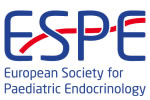hrp0097p1-98 | GH and IGFs | ESPE2023
Evaluation of patients with growth hormone deficiency during the transition period
Bensalah Meriem , Iabbassen Malek , Haffaf Lounes , Bouchenna Amira , Lachkhem Aicha , Yahi Abdelkader , Sellal Zoubir , Medjaher Meriem , Khadidja Ouldkablia Samia
hrp0095p2-262 | Sex Differentiation, Gonads and Gynaecology, and Sex Endocrinology | ESPE2022
Analyze of clinical, biological and therapeutic aspects of 46 XY DSD
Iabbassen Malek , Bensalah Meriem , Brahimi Hanane , Benabdellatif Katia , Sellal Zoubir , Zahaf Hamid , Mouloud Benaired Amine , Choutri Hichem , Khadidja Ouldkablia Samia
hrp0089p3-p288 | Pituitary, Neuroendocrinology and Puberty P3 | ESPE2018
Bilateral Optic Nerve Hypoplasia Revealing Septo Optic Dysplasia or De Morsier Syndrome: A Case Report
Yamina Aribi , Meriem Bensaleh , Lila Brakni , Zoubir Sellal , Aicha Lachkhem , Samia Ouldkablia
hrp0095p1-560 | Pituitary, Neuroendocrinology and Puberty | ESPE2022
Craniopharyngiomas in children: Hormonal profile and regional complications
Faraoun Khadra , Chentli Farida , Zoubir Safia , Midoun Nori
hrp0095p1-162 | Pituitary, Neuroendocrinology and Puberty | ESPE2022
Complications of non-endocrine pituitary tumors in children, in the city of Oran
Faraoun Khadra , Chentli Farida , Zoubir Safia , Midoun Nori
hrp0086fc5.3 | Management of Disorders of Insulin Secretion | ESPE2016
Glibentek, a New Suspension of Glibenclamide for Patients with Neonatal Diabetes, is as Effective and more Convenient than Crushed Tablets
Beltrand Jacques , Godot Cecile , Busiah Kanetee , Djerada Zoubir , Baron Sabine , Tallec Claire Le , Tessier Raphael , Ribault Virginie , Cartigny Maryse , Bruel Henri , Gozalo Claire , Treluyer Jean-Marc , Elie Caroline , Polak Michel
hrp0097p2-147 | Pituitary, Neuroendocrinology and Puberty | ESPE2023
Posterior Sellar Spine - an unusual cause of precocious puberty
Samad Punekar Abdul , Shehab Mostafa , Ehtisham Sarah
hrp0092p1-252 | Pituitary, Neuroendocrinology and Puberty (1) | ESPE2019
Brain Malformations and Sellar Spine as Possible Causes of Central Precocious Puberty in a Large Monocentric Study
Fava Daniela , Calandrino Andrea , Morana Giovanni , Gastaldi Roberto , Allegri Anna Elsa Maria , Napoli Flavia , Roviglione Barbara , Di Iorgi Natascia , Maghnie Mohamad
hrp0094p2-360 | Pituitary, neuroendocrinology and puberty | ESPE2021
In vivo magnetic resonance spectroscopy as a non-invasive tool for the identification of a sellar tumour in a boy with precocious puberty.
Kosteria Ioanna , M. Gavra Maria , Vlachopapadopoulou Elpis-Athina , A. Verganelakis Dimitrios , Dikaiakou Eirini , Vartzelis Georgios , Michalakos Stefanos ,
hrp0094p2-383 | Pituitary, neuroendocrinology and puberty | ESPE2021
Langerhans Cell Histiocytosis with Isolated Central Diabetes Insipidus, Low Grade Fever and Sellar Erosion
OKUR Iclal , ARI Hasan , Cetinkaya Semra , Emine Derinkuyu Betul , Caglar Gizem , Gokce Cinar Hasibe , Yesil Sule , Savas-Erdeve Senay ,



